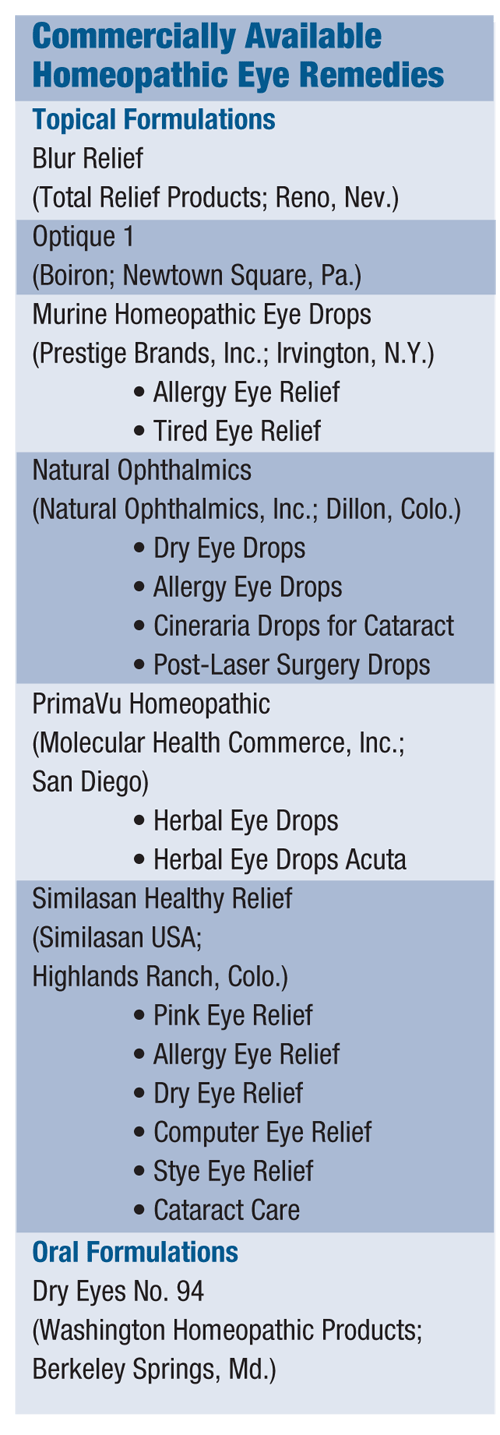 Homeopathy, or homeopathic medicine, has been a recognized specialty for more than 200 years, long before optometry was conceived as an independent profession. Some have (incor- rectly) used the term to describe the use of nutritional supplements, such as flaxseed oil for dry eye, while others list homeopathy among several elements of fringe eye care.1,2
Homeopathy, or homeopathic medicine, has been a recognized specialty for more than 200 years, long before optometry was conceived as an independent profession. Some have (incor- rectly) used the term to describe the use of nutritional supplements, such as flaxseed oil for dry eye, while others list homeopathy among several elements of fringe eye care.1,2
In this months column, we examine the basic tenets of homeopathy and its relevance to optometry, and offer an evidence-based analysis of the pertinent literature.
Root of the Matter
The discipline of homeopathy is usually attributed to Samuel Christian Hahnemann (17551843), a German physician.3 Dr. Hahnemann hypothesized that certain disease states may be treated by employing a dilution of herbs, mineral salts and other biological extracts that induce comparable toxicologic symptoms; he called this the Principle of Similars. The premise: Tiny amounts of noxious substances may help stimulate the bodys own innate healing response, thus overcoming the disease state.
For example, if a patient suffers from nausea and vomiting, a homeopathic physician might use ipecacuanha. This herb is derived from the same plant root that produces syrup of ipecac, a well-known emetic used in conventional medicine.
Homeopathy employs miniscule concentrations of such agents, diluted in series and agitated between each dilution. This process, referred to as potenization, is believed to release the vital forces within the substance.3,4
Since its inception, homeopathy has been a controversial subject within medical circles. Most traditional physicians of Dr. Hahnemanns era dismissed homeopathy as a cheat, believing that the treatments contained no biologically active elements that effect a cure.5
Then again, conventional medicine in those days was also suspect. Practices such as bloodletting, leeching and purging were common, and surgery often resulted in severe infection due to poor antiseptic techniques. The homeopathic concept of using diluted natural herbs and other extracts to balance disease was, in some ways, less harmful and perhaps even more beneficial than conventional medical therapy.
 Modern-Day Derivations
Modern-Day Derivations
Today, homeopathy still has many critics, but it has many proponents as well. An estimated 3,000
The sale of homeopathic medications in the
The Food & Drug Administration (FDA) regulates homeopathic remedies differently than it does other drugs. If the active ingredients are recognized by the HPUS, the product is considered a homeopathic formulation. The stipulations for homeopathic preparations: The imprint must identify the manufacturer and must specify that the drug is homeopathic. Also, each product must display a list of its indications (i.e., medical conditions that the product is designed to treat), and the ingredients, dilutions, and instructions for safe use.
Within eye care, homeopathy has numerous purported applications and commercially available products (see Commercially Available Homeopathic Eye Remedies,). Most remedies are aimed at management of ocular surface disorders, such as dry eye, ocular allergy and general ocular discomfort. Homeopathic formulations have also been proposed for the management of much more significant ocular pathologies, including hordeola, dacryocystitis, pterygium, cataracts, glaucoma, retinal hemorrhages and even optic atrophy.9
But, while the Internet offers much positive testimony from patients and physicians alike, there is little scientific evidence in the peer-reviewed literature to suggest that homeopathic remedies are of any significant value, particularly within eye care.
The main argument made by critics of homeopathy is that the remedies deliver nothing more than a placebo effect. Several comprehensive, independent meta-analyses have examined this issue with regard to randomized, placebo-controlled studies.11-13 These reviews concluded that the quality of clinical research in homeopathy is low.10 When only high-quality studies were analyzed (e.g., those with adequate randomization, masking, sample size, etc.), however, a substantial number demonstrated greater efficacy in favor of homeopathy than placebo.
Among specific ailments, allergic disorders may be the most responsive to homeopathic therapy.14-15 One 1995 study evaluated Similasan Eye Drops #2 (i.e., Allergy Eye Relief) vs. placebo for allergic conjunctivitis by using a conjunctival allergen challenge model.16 Results showed a statistically significant improvement for both redness and itching compared to baseline using the homeopathic remedy. The placebo group also showed a statistically significant improvement for these outcomes, however, which is highly unusual in this type of clinical trial. The study concluded that Similasan eye drops were effective, but not superior to placebo (saline drops) in the treatment of allergic conjunctivitis.
Unfortunately, there is no evidence of published, prospective clinical trials for any other homeopathic formulations listed in the table.
So, what role should homeopathy play in our management of various ocular disorders? How should we advise patients who inquire about homeopathy, or who tell us that they are using a homeopathic formulation rather than a conventional therapeutic agent?
Perhaps the best approach is one of cautious optimism. Typically, we explain that these agents are safe and well tolerated by most patients, but they have not been shown unequivocally to provide therapeutic benefit in controlled studies.
We warn patients against using these remedies in potentially sight-threatening conditions (e.g., bacterial keratitis or glaucoma), in which pharmacologic and/or surgical intervention is the standard of care. But, for non-sight-threatening conditions, such as dry eye or allergic conjunctivitis, we suggest that homeopathic formulations may be used as long as the patient feels that there is some therapeutic advantage.
Many individuals today believe in holistic or alternative therapies, but until homeopathic medicine shows specific and irrefutable efficacy in controlled clinical trials, we will likely not endorse this approach as a primary form of ocular therapy.
1. Boland MR, Flickinger JB, Flickinger EJ. Troubleshooting dry eye. Review of Contact Lenses 2002;139(11):12-14.
2. Chou B. Exposing the secrets of fringe eye care. Rev Optom 2004 Sept;141(9): 63-70.
3. Jonas WB, Kaptchuck TJ, Linde K. A critical overview of homeopathy. Ann Intern Med 2003 May;138(5):393-9.
4. Smith GK. Science and the Unknown.
5. Leland PW. Empiricism and its causes.
6. Homeopathy Timeline: 1975-Present. 2006. Available: www.wholehealthnow.com/homeopathy_pro/homeopathy_1975.html. Last accessed 6 June 2007.
7. Brinkaus B, Schindler G, Linder M, et al. Socioeconomic aspects of homoeopathy as seen by decision-makers and service providers in the health care system. In: Ernst E, Hahn E, eds. Homoeopathy: A Critical Appraisal.
8.
9. Chand DH. Role of homoeopathy in ophthalmological conditions. Indian J Ophthalmol 1982 Apr;30(4):245-8.
10. Jonas WB, Kaptchuk TJ, Linde K. A critical overview of homeopathy. Ann Intern Med 2003 May;138(5):393-9.
11. Linde K, Clausius N, Ramirez G, et al. Are the clinical effects of homeopathy placebo effects? A meta-analysis of placebo controlled trials. Lancet 1997 Sept 20;350(9081):834-43.
12. Linde K, Melchart D. Randomized controlled trials of individualized homeopathy: a state-of-the-art review. J Altern Complement Med 1998 Apr;4(4):371-88.
13. Cucherat M, Haugh MC, Gooch M, Boissel JP. Evidence of clinical efficacy of homeopathy. A meta-analysis of clinical trials. HMRAG. Homeopathic Medicines Research Advisory Group. Eur J Clin Pharmacol 2000 Jan;56(1):27-33.
14. Ludtke R, Wiesenauer M. [A meta-analysis of homeopathic treatment of pollinosis with Galphimia glauca]. Wien Med Wochenschr 1997;147(14):323-7.
15. Taylor MA, Reilly D, Llewellyn-Jones RH, et al. Randomised controlled trial of homoeopathy versus placebo in perennial allergic rhinitis with overview of four trial series. BMJ 2000 Aug 19-26;321(7259):471-6.
16. Abelson MB, George MA, Garofalo C, Weintraub D. An effective treatment for allergy sufferers. Contact Lens Spectrum 1995 Dec;30(12):28-32.

